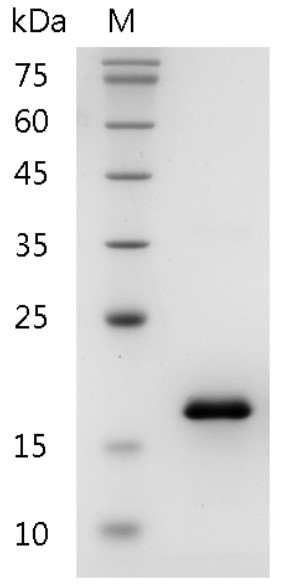| Product name | Mouse CCL2 protein , His tag (Animal-Free) |
| Sequence | Amino acid sequence derived from Mouse CCL2 (Gln24-Asn148) (P10148) with 6×His tag at the N-terminus was expressed |
| Applications | His tag |
| Applications notes | Mouse |
| Activity | Measure by its ability to chemoattract BaF3 cells transfected with CCR2A. The ED₅₀ for this effect is <8 ng/mL. |
| Protein length | The secreted Mouse CCL2 consists of 125 amino acids and has a predicted molecular mass of 14.6 kDa |
| Preparation method | E. coli |
| Purity | >98% as determined by SDS-PAGE. |
| Alternative | Monocyte Chemotactic Protein-1,MCP-1,JE |
| Formulation | Lyophilized from sterile PBS, pH 7.4 |
| Features & Benefits | Endotoxin:<0.1 EU per 1 μg of the protein by the LAL method. |
| Molecular weight | The protein has a calculated MW of 14.65 kDa.The protein migrates as 17-25 kDa under reducing condition (SDS-PAGE analysis). |
| Usage notes | Always centrifuge tubes before opening. It is recommended to reconstitute the lyophilized Mouse CCL2 protein to a concentration of 0.1-1 mg/mL in sterile ddH2O, and keep at room temperature for at least 20 min to fully dissolve. Please avoid vortex vigorously |
| Storage instructions | Lyophilized protein product should be stored desiccated below -18°C. Upon reconstitution, the protein should be stored at 4°C between 2-7 days and for future use below -18°C. For long term storage it is recommended to add a carrier protein (5% HSA , 10%FBS or 0.1%BSA). Please prevent freeze-thaw cycles |
| Shipping | Gel pack with blue ice. |
| Precautions | The product listed herein is for research use only and is not intended for use in human or clinical diagnosis. Suggested applications of our products are not recommendations to use our products in violation of any patent or as a license. We cannot be responsible for patent infringements or other violations that may occur with the use of this product. |
| Background | C-C motif chemokine 2 (CCL2) is a member of C-C or β chemokine family. There is 82% amino acid (aa) identity between mouse CCL2 and rat CCL2, and 58%, 56%, 55%, 53% and 53% aa identity with human, horse, pig, cow and dog CCL2, respectively. Fibroblasts, glioma cells, smooth muscle cells, endothelial cells, lymphocytes and mononuclear phagocytes can produce CCL2 constitutively or under mitogenic stimulation, but monocytes and macrophages seem to be the main sources. In addition to its chemotactic activity, CCL2 also induces monocytes, NK cells and lymphocytes to release enzymes and cytokines, and basophils expressing its receptor CCR2 to release histamine. CCL2-mediated recruitment of monocytes to inflammatory sites is considered to play a role in the pathology of atherosclerosis, multiple sclerosis and allergic asthma. |
| Alternative | Monocyte Chemotactic Protein-1,MCP-1,JE |
| Accession | P10148 |

Fig.SDS-PAGE analysis of Mouse CCL2 protein
You must be logged in to post a review.
Reviews
There are no reviews yet.